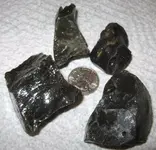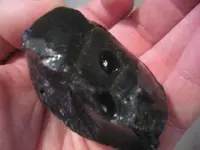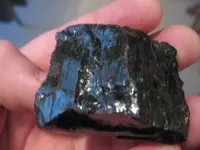It's common slag glass. It has all the signs.
For those that believe in obsidian in Illinois - I've got a bridge to sell you. There is no (zero) obsidian in Illinois or anywhere east of there. The entire east coast is devoid of obsidian. Look up
devitrification to see why.
Agree with slag glass, and that there is no obsidian in Illinois.
What I say below is intended more as a clarification of there being no obsidian on the East Coast rather than a contradiction of what you said, since there are sources within about 120 miles of the coastline, but they’re minor.
Almost every lightweight ‘geological reference source’ (and many authoritative heavyweight sources) trot out that obsidian is not found in the Eastern United States… often expressed as “doesn’t occur naturally east of the Mississippi River”.
The rationale for the statement is that obsidian readily weathers and hydrates to form the brownish-grey opaque mineral “perlite” and it typically only takes a few million years for this to happen ['devitrification', as you said]. Given that there hasn’t been volcanic activity on the eastern side of the continent within that time, there should be no obsidian remaining and it’s generally assumed that the Native American artefacts made from it found in eastern areas were the result of trading (of material) from outside the area.
That’s only a partial truth. Obsidian can and does survive a lot longer than that, but with most specimens being younger than 50 million years and nothing has been found that’s older than 66 million years. However, the geological record suggests that there should be no magmatic flows in the eastern parts of the USA from which obsidian could have formed within the last 200 million years.
That’s now known to be untrue, notably for Virginia. The state has two ‘young’ volcanoes in the Appalachian Mountains: Mole Hill and Trimble Knob. Both of them are less than 48 million years old and exist today as the heavily-eroded necks and remnants of the interior of primeval volcanoes. They do nevertheless have the remains of gaseous vents within which there is still unweathered obsidian, first identified and documented by geologists in 1899. A few of the obsidian artefacts found in Virginia have definitively been attributed to these sources, so ancient people must have discovered them. The other possibility is that the Smith and Dan Rivers which originate from the Blue Ridge and Appalachian Mountains carry occasional pieces of obsidian from these sources into the Piedmont along the NC/VA border and that’s where many of the obsidian artefacts have been found. These tools also typically date between 2,000 – 10,000 BC, which is well before trading networks are known to have existed. The trade in lithics was extensive during the Woodland Period but doesn’t seem to predate 100 BC (Hopewell Culture).
Recent research suggests that the East Coast is not a volcano-free “passive margin” but actually a “passive-aggressive margin” that saw volcanic activity much more recently than originally believed and, although its volcanoes are now extinct, things are still rumbling below the surface. That’s the reason for the 5.8 magnitude earthquake centred near Mineral, VA in 2011. Mole Hill and Trimble Knob are believed to be part of a ‘swarm’ of volcanoes that co-existed, but the only readily recognisable ones today.









